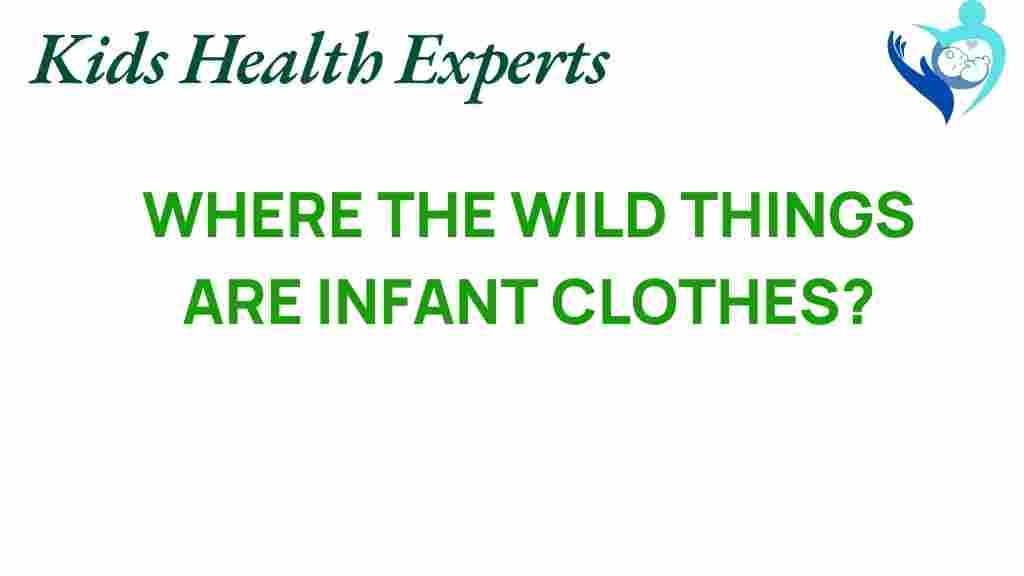Where the Wild Things Are: The Surprising World of Infant Clothing
When it comes to infant clothing, parents today are looking for more than just cute designs and convenience. The rise of sustainable fashion has transformed the way we think about baby apparel, with a focus on eco-friendly materials and practices that support both our little ones and the planet. As trends evolve, understanding the intersection of creativity, wildlife, and responsible shopping becomes essential for modern parenting.
The Shift Towards Sustainable Infant Clothing
A growing number of parents are opting for eco-friendly baby apparel, which prioritizes sustainability without sacrificing style. This shift is driven by several factors:
- Health Concerns: Parents want to ensure that the fabrics touching their baby’s skin are free from harmful chemicals.
- Environmental Impact: A desire to reduce waste and carbon footprints is leading more families to choose organic and sustainable materials.
- Ethical Production: Many consumers are increasingly concerned about the labor practices behind the clothing they purchase.
Key Trends in Sustainable Infant Clothing
As we explore the world of infant clothing, let’s take a closer look at the latest trends in sustainable fashion:
- Organic Cotton: Many brands are now using organic cotton, which is grown without harmful pesticides and chemicals.
- Recycled Materials: Some companies are innovating by creating fabrics from recycled plastic bottles and textiles.
- Biodegradable Fabrics: Emerging brands are focusing on creating clothing that breaks down naturally over time, minimizing landfill waste.
- Animal-Friendly Options: Vegan baby apparel is on the rise, promoting cruelty-free materials and designs.
Creative Designs Inspired by Wildlife
The influence of wildlife on infant clothing design cannot be overstated. Many brands are drawing inspiration from nature, incorporating playful animal motifs and organic shapes into their collections. This not only captures the imagination of parents but also promotes a connection to the environment.
Consider the following design elements:
- Animal Prints: From forest friends to ocean creatures, animal prints are a playful way to celebrate wildlife.
- Nature-Inspired Colors: Earth tones and pastel shades reflect the serenity of the natural world.
- Interactive Features: Clothing that includes textures or detachable animal features can engage a child’s curiosity and creativity.
Shopping for Eco-Friendly Infant Clothing
When it comes to shopping for baby apparel, there are several strategies to ensure you are making environmentally responsible choices:
1. Research Brands
Before purchasing, take some time to research brands that prioritize sustainability. Look for certifications like GOTS (Global Organic Textile Standard) or OEKO-TEX, which indicate commitment to eco-friendly practices. You can also visit sustainable fashion directories to find reputable brands.
2. Check Materials
Always read the labels to understand what materials are used in the clothing. Opt for organic and natural fabrics wherever possible, as these are less harmful to the environment and safer for your baby.
3. Consider Second-Hand Options
Shopping second-hand is a fantastic way to reduce waste. Many thrift stores and online marketplaces offer gently used infant clothing that is still in excellent condition. This option not only saves money but also promotes a circular economy.
4. Invest in Versatile Pieces
Choose clothing that can adapt as your baby grows. Look for items that have adjustable features or styles that are suitable for multiple occasions to maximize their usage.
5. Embrace Minimalism
With infants growing quickly, it’s easy to accumulate a lot of clothing. Embracing a minimalist approach can help you focus on quality over quantity, investing in fewer pieces that are durable and timeless.
Troubleshooting Common Issues in Infant Clothing
Even with the best intentions, parents may encounter challenges when selecting infant clothing. Here are some common issues and how to address them:
1. Sizing Problems
Issue: Babies grow quickly, and sizing can be tricky.
Solution: Always check sizing charts before purchasing. Consider buying a size up to accommodate growth.
2. Difficult Care Instructions
Issue: Some eco-friendly fabrics may have specific washing instructions.
Solution: Look for clothing that is machine washable and easy to care for. Read care labels carefully.
3. Limited Availability
Issue: Sustainable brands may have limited stock or availability.
Solution: Sign up for newsletters from your favorite brands to stay updated on restocks and new releases.
4. Budget Constraints
Issue: Eco-friendly clothing can sometimes be more expensive.
Solution: Consider setting a budget and focusing on key pieces that offer versatility and durability. Look for sales and discounts to make sustainable options more affordable.
Conclusion: A Wild Adventure in Infant Clothing
The world of infant clothing is more than just a necessity; it’s an exciting journey into sustainable fashion, creativity, and wildlife. By choosing eco-friendly options, parents not only provide their babies with safe and stylish apparel but also contribute to a healthier planet.
As you navigate the trends and designs, embrace the whimsical spirit of childhood and the importance of responsible shopping. Together, we can nurture a generation that values sustainability and creativity, one adorable outfit at a time.
For more insights into sustainable parenting and shopping, check out our comprehensive guide on eco-friendly choices!
This article is in the category Growth and created by KidsHealthExperts Team
